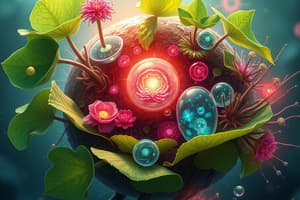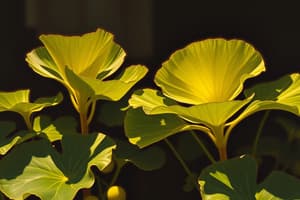Podcast
Questions and Answers
Where does the Calvin Cycle take place?
Where does the Calvin Cycle take place?
In the stroma of the chloroplasts.
What are the three phases or steps of the Calvin Cycle?
What are the three phases or steps of the Calvin Cycle?
Fixation, reduction, and regeneration.
What happens during fixation?
What happens during fixation?
RuBisCo combines with RuBP and CO2 forming a 6 carbon molecule that immediately breaks down into a 3 carbon PGA.
What is the name of the enzyme that makes fixation happen?
What is the name of the enzyme that makes fixation happen?
What happens during the reduction phase of the Calvin Cycle?
What happens during the reduction phase of the Calvin Cycle?
How does the reduction phase link the light reactions to the Calvin Cycle?
How does the reduction phase link the light reactions to the Calvin Cycle?
What happens during the regeneration phase of the Calvin Cycle?
What happens during the regeneration phase of the Calvin Cycle?
Flashcards
Where does the Calvin Cycle happen?
Where does the Calvin Cycle happen?
The Calvin Cycle takes place in this part of the chloroplast.
What is fixation?
What is fixation?
This is the first step of the Calvin Cycle, where carbon dioxide is incorporated into an organic molecule.
What is RuBisCo?
What is RuBisCo?
RuBisCo is the enzyme that catalyzes the reaction of CO2 with RuBP in the Calvin Cycle.
What happens during the reduction phase?
What happens during the reduction phase?
Signup and view all the flashcards
What happens during the regeneration phase?
What happens during the regeneration phase?
Signup and view all the flashcards
How does the reduction phase link the light reactions to the Calvin Cycle?
How does the reduction phase link the light reactions to the Calvin Cycle?
Signup and view all the flashcards
What are the three phases of the Calvin Cycle?
What are the three phases of the Calvin Cycle?
Signup and view all the flashcards
Study Notes
Calvin Cycle Overview
- Occurs in the stroma of chloroplasts, a site crucial for photosynthesis.
- Essential for converting carbon dioxide and energy into glucose through a series of reactions.
Phases of the Calvin Cycle
- Comprises three main phases: fixation, reduction, and regeneration.
Fixation Phase
- Involves the enzyme RuBisCo, which catalyzes the reaction between carbon dioxide (CO2) and ribulose bisphosphate (RuBP).
- This reaction produces a 6-carbon molecule that quickly breaks down into two 3-carbon molecules known as phosphoglycerate (PGA).
Reduction Phase
- ATP and NADPH from light-dependent reactions convert PGA into glyceraldehyde-3-phosphate (G3P), a high-energy 3-carbon compound.
- This phase connects to light reactions, as one out of every six G3P molecules is utilized to synthesize glucose, linking energy capture to carbon fixation.
Regeneration Phase
- Involves the regeneration of ribulose bisphosphate (RuBP) using G3P and ATP.
- This step is crucial for continuing the cycle, enabling the fixation of additional carbon dioxide.
Studying That Suits You
Use AI to generate personalized quizzes and flashcards to suit your learning preferences.




